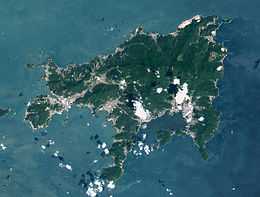Shōdo Island



Shōdo Island (小豆島 Shōdo-shima) is an island located in the Inland Sea of Japan. The name means literally "Island of Small Beans". There are two towns on the island: Tonoshō and Shōdoshima, comprising the district of Shōzu.
The island is famous as the setting for the novel Twenty-Four Eyes, and its subsequent film adaptations. The island was the first area of Japan to successfully grow olives, and is sometimes known as "Olive Island".
Geography
Shōdo-shima is part of Kagawa Prefecture and is located north of the prefectural capital Takamatsu. It has an area of 153.30 km2 (59.19 sq mi) and a coastline of 126 km (78 mi). It is the 19th largest island in Japan, and the second largest in the Inland Sea.
Shōdoshima is home to Dobuchi Strait (土渕海峡 Dobuchi-kaikyō) the world's narrowest strait, 9.93 m (32.58 ft) meters at its narrowest.
Frequent ferries run to the island from Takamatsu, Himeji, Teshima and Okayama. Ferries run infrequently to Osaka and Kōbe as well.
History
Shōdo-shima was once known as Azuki-shima and was part of Kibi (later Bizen) Province, given to Sanuki Province, and finally made part of Kagawa prefecture.
Tourism and culture
Shōdo-shima is a popular destination for domestic tourism in Japan. In addition to natural features such as the Dobuchi Strait, the Angel Road, Shōdoshima Olive Park and the Kanka Gorge (寒霞渓 Kanka-kei), Shōdo-shima is famous as the setting for the antiwar novel Twenty-Four Eyes (二十四の瞳 Nijūshi no Hitomi), written by the native author Sakae Tsuboi and later turned twice into a film (1954 and 1987), as well as a television special.[1][2] The island is the birthplace of two other distinguished writers: Sakae's husband the poet Shigeji Tsuboi and the novelist and short-story writer Denji Kuroshima. All three were prominent participants in the proletarian literary movement, an important and politically radical current within modern Japanese literature.
Shōdo-shima is also known for its olives, soy sauce, wild monkeys, and beaches. In addition, tourists are attracted to a miniature version of the 88-temple Shikoku Pilgrimage.
The island is also famous for being the first in Japan to successfully cultivate olives. Olive trees proliferate on the island and olive-related merchandise is quite popular with tourists. Milos, Greece is Shōdo-shima's sister island.
Sister island

See also
Notes
- ↑ "Twelve Sets of Eyes". TMS Entertainment. Retrieved 30 August 2011.
- ↑ "二十四の瞳" (in Japanese). TMS Entertainment. Retrieved 30 August 2011.
External links
| Wikimedia Commons has media related to Shodo Island. |
Coordinates: 34°30′49″N 134°17′08″E / 34.51361°N 134.28556°E
